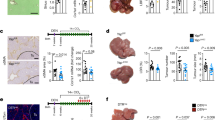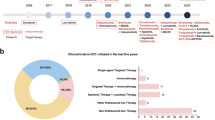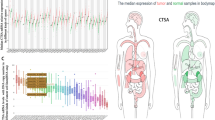Abstract
Hepatocellular carcinoma suppressor 1 (HCCS1) was discovered as a novel tumor suppressor gene. We recently observed that adenovirus-mediated gene transfer of HCCS1 leads to cytotoxicity to human hepatocarcinoma cells. Here, we have demonstrated that adenovirus-mediated overexpression of HCCS1 induces apoptosis in hepatocarcinoma cells and have further characterized the apoptotic cascade. The results showed that lysosomal cathepsin D is released into the cytosol in response to HCCS1 overexpression and consequently triggers Bax insertion into the mitochondrial membrane, which leads to the release of cytochrome c. In addition, HCCS1 overexpression can induce an increase in intracellular free Ca2+ concentration, which also results in cytochrome c release. The released cytochrome c activates downstream caspases, leading to the occurrence of the late stages of apoptosis. Moreover, we demonstrated that the disruption of HCCS1 in mice leads to embryonic lethality, accompanied by abnormal labyrinth architecture resulting from the excessive proliferation of trophoblast cells in the placenta. These results suggest that HCCS1 plays a role in apoptosis regulation and development.
Similar content being viewed by others
Log in or create a free account to read this content
Gain free access to this article, as well as selected content from this journal and more on nature.com
or
Abbreviations
- HCCS1:
-
Hepatocellular carcinoma suppressor 1
- PI:
-
prodiduim iodine
- FACS:
-
fluorescent-activated cell sorting
- PARP:
-
poly(ADP-ribose) polymerase
- BIP:
-
Bax-inhibiting peptide
- PCNA:
-
proliferation cell nuclear antigen
- DMSO:
-
dimethylsulfoxide
References
Zhao X, Li J, He Y, Lan F, Guo J, Zhao R et al. A novel growth suppressor gene on chromosome 17p13.3 with a high frequency of mutation in human hepatocellular carcinoma. Cancer Res 2001; 61: 7383–7387.
Zhao X, He M, Wan D, Ye Y, He Y, Han L et al. The minimum LOH region defined on chromosome 17p13.3 in human hepatocellular carcinoma with gene content analysis. Cancer Lett 2003; 190: 221–232.
Xiao W, Park CK, Park JY, Lee JH, Kim HS, Cho YG et al. Genetic alterations of the HCCS1 gene in Korean hepatocellular carcinoma. APMIS 2003; 111: 465–673.
Yang J, Liu X, Bhalla K, Kim CN, Ibrado AM, Cai J et al. Prevention of apoptosis by Bcl-2: release of cytochrome c from mitochondria blocked. Science 1997; 275: 1129–1132.
Gross A, Jockel J, Wei MC, Korsmeyer SJ . Enforced dimerization of BAX results in its translocation, mitochondrial dysfunction and apoptosis. EMBO J 1998; 17: 3878–3885.
Jürgensmeier JM, Xie Z, Deveraux Q, Ellerby L, Bredesen D, Reed JC . Bax directly induces release of cytochrome c from isolated mitochondria. Proc Natl Acad Sci USA 1998; 95: 4997–5002.
Cao X, Deng X, May WS . Cleavage of Bax to p18 Bax accelerates stress-induced apoptosis, and a cathepsin-like protease may rapidly degrade p18 Bax. Blood 2003; 102: 2605–2614.
Sawada M, Hayes P, Matsuyama S . Cytoprotective membrane-premeable peptides designed from the Bax-binding domain of Ku70. Nat Cell Biol 2003; 5: 352–357.
Chwieralski CE, Welte T, Bühling F . Cathepsin-regulated apoptosis. Apoptosis 2006; 11: 143–149.
Bidère N, Lorenzo HK, Carmona S, Laforge M, Harper F, Dumont C et al. Cathepsin D triggers Bax activation, resulting in selective apoptosis-inducing factor (AIF) relocation in T lymphocytes entering the early commitment phase to apoptosis. J Biol Chem 2003; 278: 31401–31411.
Nomura M, Shimizu S, Sugiyama T, Narita M, Ito T, Matsuda H et al. 14-3-3 Interacts directly with and negatively regulates pro-apoptotic Bax. J Biol Chem 2003; 278: 2058–2065.
Sawada M, Sun W, Hayes P, Leskov K, Boothman DA, Matsuyama S . Ku70 suppresses the apoptotic translocation of Bax to mitochondria. Nat Cell Biol 2003; 5: 320–329.
Susin SA, Lorenzo HK, Zamzami N, Marzo I, Snow BE, Brothers GM et al. Molecular characterization of mitochondrial apoptosis-inducing factor. Nature 1999; 397: 441–446.
Wang M, Zhang L, Han X, Yang J, Qian J, Hong S et al. Atiprimod inhibits the growth of mantle cell lymphoma in vitro and in vivo and induces apoptosis via activating the mitochondrial pathways. Blood 2007; 109: 5455–5462.
Mignotte B, Vayssière J-L . Mitochondria and apoptosis. Eur J Biochem 1998; 252: 1–15.
Yoshino T, Kishi H, Nagata T, Tsukada K, Saito S, Muraguchi A . Differential involvement of p38 MAP kinase pathway and Bax translocation in the mitochondria-mediated cell death in TCR- and dexamethasone-stimulated thymocytes. Eur J Immunol 2001; 31: 2702–2708.
Ly JD, Grubb DR, Lawen A . The mitochondrial membrane potential (Δψm) in apoptosis; an update. Apoptosis 2003; 8: 115–128.
Lim ML, Minamikawa T, Nagley P . The protonophore CCCP induces mitochondrial permeability transition without cytochrome c release in human osteosarcoma cells. FEBS Lett 2001; 503: 69–74.
Degenhardt K, Sundararajan R, Lindsten T, Thompson C, White E . Bax and Bak independently promote cytochrome c release from mitochondria. J Biol Chem 2002; 277: 14127–14134.
Stridh H, Gigliotti D, Orrenius S, Cotgreave I . The role of calcium in pre- and postmitochondrial events in tributyltin-induced T-cell apoptosis. Biochem Biophys Res Commun 1999; 266: 460–465.
Sharma AK, Rohrer B . Calcium-induced calpain mediates apoptosis via caspase-3 in a mouse photoreceptor cell line. J Biol Chem 2004; 279: 35564–35572.
Smaili SS, Hsu YT, Sanders KM, Russell JT, Youle RJ . Bax translocation to mitochondria subsequent to a rapid loss of mitochondrial membrane potential. Cell Death Differ 2001; 8: 909–920.
Gao G, Dou QP . N-terminal cleavage of bax by calpain generates a potent proapoptotic 18-kDa fragment that promotes bcl-2-independent cytochrome c release and apoptotic cell death. J Cell Biochem 2000; 80: 53–72.
Watson ED, Cross JC . Development of structures and transport functions in mouse placenta. Physiology 2005; 20: 180–193.
Wu L, de Bruin A, Saavedra HI, Starovic M, Trimboli A, Yang Y et al. Extra-embryonic function of Rb is essential for embryonic development and viability. Nature 2003; 421: 942–947.
Leiwen H, Meinhold-Heerlein I, Oliveira V, Schwarzenbacher R, Luo G, Wadle A et al. Characterization of the human GARP (Golgi associated retrograde protein) complex. Exp Cell Res 2005; 306: 24–34.
Conibear E, Stevens TH . Vps52p, Vps53p, and Vps54p form a novel multisubunit complex required for protein sorting at the yeast late Golgi. Mol Biol Cell 2000; 11: 305–323.
Pohlmann R, Boeker MW, von Figura K . The two mannose 6 phosphate receptors transport distinct complements of lysosomal proteins. J Biol Chem 1995; 270: 27311–27318.
Maianski NA, Roos D, Kuijpers TW . Bid truncation, bid/bax targeting to the mitochondria and caspase activation associated with neutrophil apoptosis are inhibited by granulocyte colony-stimulating factor. J Immunol 2004; 172: 7024–7030.
Dörrie J, Gerauer H, Wachter Y, Zunino SJ . Resveratrol induces extensive apoptosis by depolarizing mitochondrial membranes and activating caspase-9 in acute lymphoblastic leukemia cells. Cancer Res 2001; 61: 4731–4739.
Ye JL, Mao WP, Wu AL, Zhang NN, Zhang C, Yu YJ et al. Cadmium-induced apoptosis in human normal liver L-02 cells by acting on mitochondria and regulating Ca2+ signals. Environ Toxicol Pharmacol 2007; 24: 45–54.
Dempo K, Kottel RH, Fishman WH . Demonstration of species difference of placental alkaline phosphatase isozymes in acetone-fixed paraffin-embedded tissues. J Histochem Cytochem 1980; 28: 282–284.
Acknowledgements
We thank Dr. Pandolffi for generously providing the targeting vector. This work was supported by grants from the Key Programs of the National Natural Science Foundation of China (No. 30330350) and the Shanghai Committee of Science and Technology (No. 04XD14015).
Author information
Authors and Affiliations
Corresponding authors
Additional information
Edited by D Vaux
Supplementary Information accompanies the paper on Cell Death and Differentiation website (http://www.nature.com/cdd)
Rights and permissions
About this article
Cite this article
Gan, Y., Zhao, X., Hu, J. et al. HCCS1 overexpression induces apoptosis via cathepsin D and intracellular calcium, and HCCS1 disruption in mice causes placental abnormality. Cell Death Differ 15, 1481–1490 (2008). https://doi.org/10.1038/cdd.2008.73
Received:
Revised:
Accepted:
Published:
Issue date:
DOI: https://doi.org/10.1038/cdd.2008.73
Keywords
This article is cited by
-
VPS52 induces apoptosis via cathepsin D in gastric cancer
Journal of Molecular Medicine (2017)
-
Adenovirus-mediated HCCS1 overexpression elicits a potent antitumor efficacy on human colorectal cancer and hepatoma cells both in vitro and in vivo
Cancer Gene Therapy (2008)



